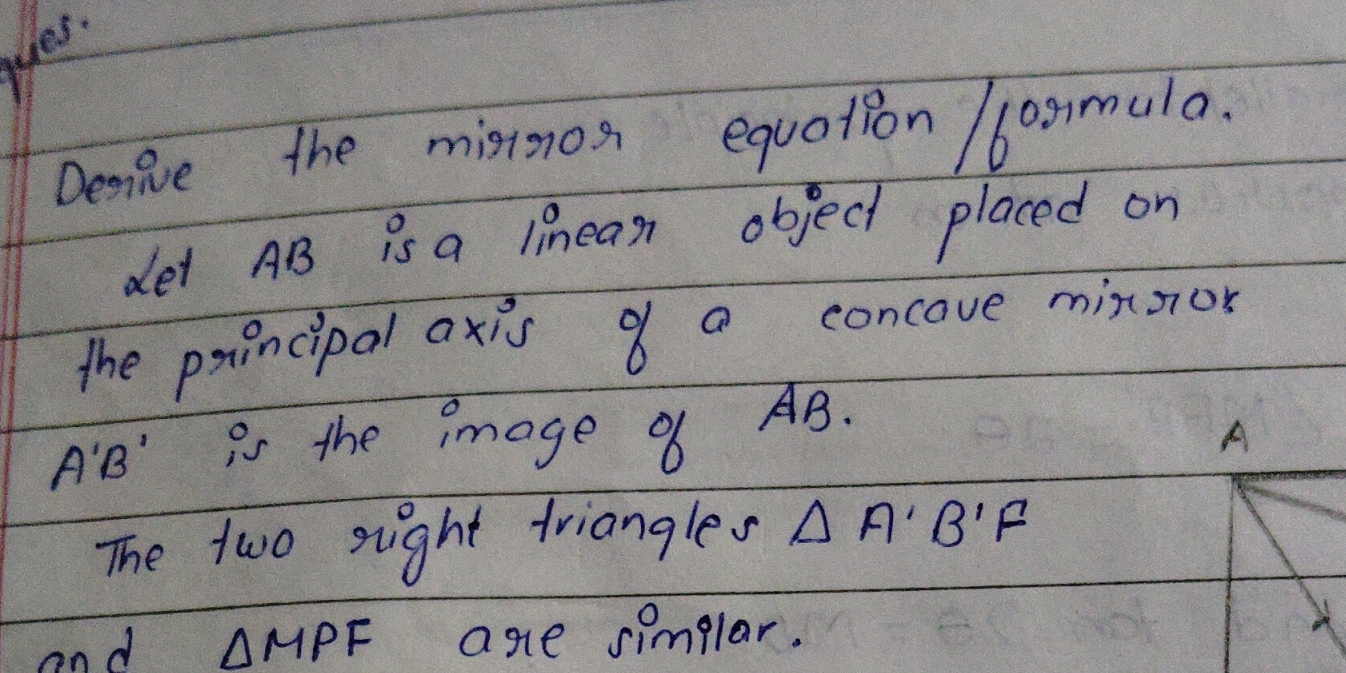Derive the mirror equation/formula. Given a linear object AB placed on the principal axis of a concave mirror, its image A'B', and the fact that triangles \(\Delta A'B'F\) and \(\D... Derive the mirror equation/formula. Given a linear object AB placed on the principal axis of a concave mirror, its image A'B', and the fact that triangles \(\Delta A'B'F\) and \(\Delta MPF\) are similar.

Understand the Problem
The question asks to derive the mirror equation or formula, based on the setup described with a linear object AB placed on the principal axis of a concave mirror, its image A'B', and the similarity of triangles (\Delta A'B'F) and (\Delta MPF).
Answer
The mirror equation is $\frac{1}{u} + \frac{1}{v} = \frac{1}{f}$.
Answer for screen readers
The mirror equation is:
$$ \frac{1}{u} + \frac{1}{v} = \frac{1}{f} $$
Steps to Solve
- Relate the sides of similar triangles $\Delta A'B'F$ and $\Delta MPF$
Since triangles $\Delta A'B'F$ and $\Delta MPF$ are similar, the ratio of their corresponding sides are equal. Therefore, we can write:
$$ \frac{A'B'}{MP} = \frac{B'F}{PF} $$
- Recognize that MP = AB.
The length of MP is equal to the length of AB because the line MP is parallel to the principal axis.
$$ MP = AB $$
Substituting $MP$ with $AB$ in the equation from step 1 gives:
$$ \frac{A'B'}{AB} = \frac{B'F}{PF} $$
- Relate the sides of similar triangles $\Delta A'B'P$ and $\Delta ABP$
Since triangles $\Delta A'B'P$ and $\Delta ABP$ are similar, we can relate their sides as follows:
$$ \frac{A'B'}{AB} = \frac{PB'}{PB} $$
- Equate the two expressions for $\frac{A'B'}{AB}$
From steps 2 and 3, we have two expressions for $\frac{A'B'}{AB}$. Equating these two gives:
$$ \frac{B'F}{PF} = \frac{PB'}{PB} $$
- Express $B'F$ in terms of $PB'$ and $PF$
We can write $B'F$ as:
$$ B'F = PB' - PF $$
Substitute this into the equation from step 4 to get:
$$ \frac{PB' - PF}{PF} = \frac{PB'}{PB} $$
- Use sign conventions and substitute variables
Let $PB = -u$ (object distance), $PB' = -v$ (image distance), and $PF = -f$ (focal length). Note that for a concave mirror, all these quantities are negative. Substituting these into the equation from step 5:
$$ \frac{-v - (-f)}{-f} = \frac{-v}{-u} $$
$$ \frac{-v + f}{-f} = \frac{v}{u} $$
- Simplify the equation
Simplify the equation from step 6:
$$ \frac{f - v}{-f} = \frac{v}{u} $$
$$ 1 - \frac{f}{v} = -\frac{f}{u}$$
$$ u(f-v) = -vf$$ $$ uf -uv = -vf$$ $$ uf + vf = uv$$
- Divide by $uvf$
Divide both sides of the equation by $uvf$:
$$ \frac{uf}{uvf} + \frac{vf}{uvf} = \frac{uv}{uvf} $$
$$ \frac{1}{v} + \frac{1}{u} = \frac{1}{f} $$
This is the mirror equation.
The mirror equation is:
$$ \frac{1}{u} + \frac{1}{v} = \frac{1}{f} $$
More Information
The mirror equation relates the object distance ($u$), the image distance ($v$), and the focal length ($f$) of a spherical mirror. It holds true for both concave and convex mirrors, provided the sign conventions are followed strictly.
Tips
A common mistake is not using the correct sign conventions for $u$, $v$, and $f$. For concave mirrors, $f$ is positive, while for convex mirrors, $f$ is negative. Real images have positive $v$ and virtual images have negative $v$. The object distance $u$ is usually positive, but it can be negative in some situations, like when dealing with virtual objects. Another common mistake is incorrectly manipulating the algebraic expressions while deriving the formula, such as not distributing negatives properly or making errors when dividing.
AI-generated content may contain errors. Please verify critical information